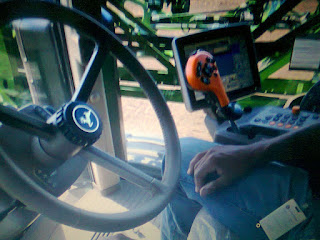 contribution by cnet.com
contribution by cnet.com
Agribusiness, Agriculture, Veterinary Medicine, Cassava, Garri, food security, Agritech and the Red Meat Value Chain.
Wednesday, July 6, 2016
Precision agriculture and unmanned tractors.
Cory Anstey always wanted to be a farmer. It was the joy of riding in the tractor, "the smell of the dirt in the spring" that drew him to the fields. Anstey, 44, is also a bit of a techie. Luckily for him, modern agriculture lets him embrace both of his passions. Anstey started using GPS technology in his machinery about 15 years ago and now even lets his tractor steer itself across his fields.
"It's very addictive, once you've had it," he tells me while taking a break at the 21st Century Cooperative, a mechanic shop/gas station/grain elevator in Cumberland, Iowa. Known simply as "the Co-op," the dusty office with grimy floors is the most popular hangout in this town of 250 people. It's here where farmers, many clad in overalls and boots, gather to drink pop (soda, for those not in the Midwest), snack on popcorn and gossip -- which includes chatter about the latest machines.
As farmers work more acres with the same -- or even less -- manpower and bigger, more unwieldy machines, they're increasingly turning to technology for help. But it's not the usual tech suspects like Google or Apple inventing a better pitchfork; instead, traditional agriculture machinery manufacturers like John Deere and New Holland keep stepping up their innovation.
Self-driving tractors are commonplace (the farmer still sits behind the wheel). Sensors can detect everything from what the machine's doing to what the crop conditions are. Farmers can monitor the progress of planting and harvesting from their iPads, and tractors serve as their own mobile hotspots. It's a skewed reflection of our own increasingly connected world, except farmers have used many of those technologies, like auto-steering and GPS mapping, since the '90s.
It used to take years for farmers to figure out the condition of their land. Today, a farmer doesn't need much institutional knowledge about the field he's working -- his tractor knows all, thanks to GPS mapping. Location tech manages three quarters of the acres farmed in Iowa, Darr said.
Mapping technology talks to sensors in the machines, letting farmers track what's going on at each location, like yield and moisture level. You can see the info on a display built into the tractor, like a big GPS display. The data gets saved in the cloud and can be accessed on computers and tablets. Many farmers even mount iPads in their tractors as second monitors.
The saying about real estate is location, location, location," said Ron Zink, John Deere's director of onboard applications. "It's the same with precision ag. You need to know exactly where you are."
Planters have auto-shutoff technology that uses GPS to make sure a farmer doesn't accidentally plant an area twice, saving seeds, fuel and time. They can be nearly perfect in spacing seeds apart from each other, compared with only about 60 percent accuracy with planters from 10 years ago, according to Darr.
Farmers can follow their yield in real time as they harvest their fields or go back to the data later. And the machines themselves collect information like the temperature of the engine, the amount of fuel used and the location of that machine, letting farmers repair and maintain equipment.
 contribution by cnet.com
contribution by cnet.com
 contribution by cnet.com
contribution by cnet.com
Subscribe to:
Post Comments (Atom)
Agribusiness ideas.
Popular Posts
-
When an agile,active bird dog was diagnosed with osteosarcoma,the owners sought out options that will ensure survival and longevity. This ...
-
Keeping pet trim is good for pet's health and owners' money. Feeding pets indiscriminately with food high in sugar, fat and cert...
-
WHO warned that a large epidemic of yellow fever is possible in Brazil after dozens of suspected deaths from the disease were reported in ...
-
Five ways agriculture could benefit from artificial intelligence. Agriculture is the industry that accompanied the evolution of humanity ...
-
Digital technology has made its way into various industries but its impact in agriculture has the highest advantages with food security bei...
-
The bird flu outbreak sweeping across Asia and Europe means you may soon be eating more Brazilian chicken. The world’s top exporter h...
AGRIBUSINESS EDUCATION.
Translate
I-CONNECT -AGRICULTURE
AGRIBUSINESS TIPS.
AGRIBUSINESS.
The Agriculture Daily
veterinarymedicineechbeebolanle-ojuri.blogspot.com Cassava: benefits of garri as a fermented food. Cassava processing involves fermentation which is a plus for gut health. The fermentation process removes the cyanogenic glucosides present in the fres...



No comments:
Post a Comment